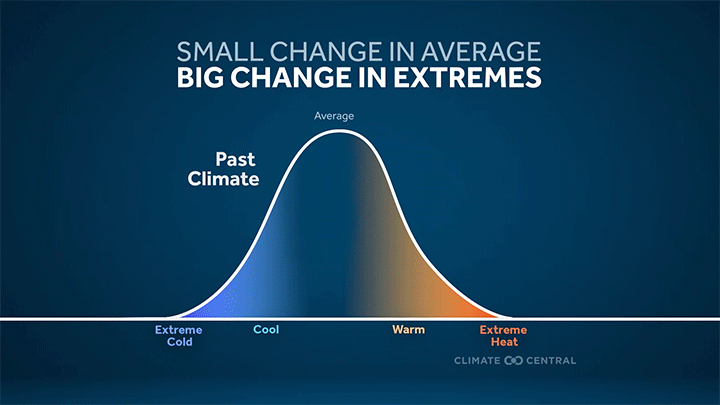Climate Matters•June 21, 2022
Introducing the Climate Shift Index
KEY CONCEPTS
Today, Climate Central launches the Climate Shift Index ™ —a new tool that shows the local influence of climate change, every day.
Climate Shift Index ™ (CSI) levels indicate how much climate change has altered the frequency of daily temperatures at a particular location.
Starting today, Climate Central will be updating the Climate Shift Index ™ daily with interactive maps and 3-day CSI forecasts available for locations across the continental U.S.
Climate Shift Index ™ levels, maps, and forecasts can now be used in real-time to help the public understand that climate change is not just about long-term trends—it’s already part of our daily lives.



Climate change is disrupting our world—and shifting our daily lives.
From heatwaves to hurricanes, many extreme weather events are now more frequent or intense due to climate change. But climate change doesn’t only affect extreme weather. In fact, the weather we experience on most days also bears the fingerprints of human-caused climate change. Climate Central’s new tool—the Climate Shift Index ™ —decodes these fingerprints, every day.
The Climate Shift Index ™ reveals the local influence of climate change—every day.
The Climate Shift Index ™ (CSI) indicates how climate change has altered the frequency of both the daily high and low temperatures at a given location. Climate Central updates the CSI daily with interactive maps, including forecasts for the next three days, for the continental U.S. Localized graphics will be available in a few weeks.
Interpreting the Climate Shift Index
The Climate Shift Index ™ has 11 levels: five positive, five negative, and one representing no change.
CSI levels from +1 to +5 indicate that human-caused climate change has made the observed or forecasted temperatures more likely or, equivalently, more common.
CSI levels from -1 to -5 indicate temperatures that are becoming less likely or less common due to human-caused climate change.

Show your Warming Stripes. Show your Climate Shift.
On #ShowYourStripes day (June 21), we share the iconic warming stripes graphics to help raise public awareness of warming trends over the last 100+ years. Similarly, the Climate Shift Index ™ is a novel communication tool that can help the public understand that climate change is not just about long-term trends—that it’s a part of our lives right now, every day.
Four ways to start using the Climate Shift Index ™ today:
Visit the CSI webpage. Check back for daily updates to the national CSI maps and local 3-day CSI forecasts. The webpage also includes video demos of the CSI tool, detailed explanations of the peer-reviewed science and methods behind the CSI, and a FAQ page.
Sign up for Realtime Climate alerts to receive an email notice when there are high CSI levels in your local area.
Join us on June 23 for a CSI briefing. Learn more about CSI directly from the Climate Central scientists behind it during a series of virtual briefings that include live demos and interactive Q&A’s.
Show your Climate Shift. Share your local CSI levels on social media to let others know how much climate change has altered daily temperatures in your local area.
How does the Climate Shift Index ™ work?
The Climate Shift Index ™ is grounded in the latest peer-reviewed climate change attribution science, continuing Climate Central’s sustained contributions to this groundbreaking area of research.
The Climate Shift Index ™ is based on the ratio of the local frequency of a particular daily temperature in the current climate to the estimated frequency of that temperature in a world without human-caused climate change.
The Climate Shift Index ™ is based on two complementary approaches: one based on observations, and one based on climate model analyses. For increased robustness, the CSI level is assigned based on the combination of the observation-based and model-based estimates of human-caused changes in an event's frequency.
For more detailed information on Climate Shift Index ™ calculations, see the FAQs and our peer-reviewed methods paper.
The Climate Shift Index ™ for temperature is the first in a series of tools being developed by Climate Central’s new Realtime Fingerprints program, which advances the science of climate change attribution to help reveal how climate change is disrupting our world—and our daily lives today.
POTENTIAL LOCAL STORY ANGLES
The CSI shows us how local, daily weather conditions have been altered by human-caused climate change, and allows us to connect climate change with important events as they unfold. The CSI has the potential to transform where, when, and how we understand and talk about the effects of human-caused climate change on our daily lives.
Meteorologists can incorporate the Climate Shift Index ™ into their daily forecast using the 3-day CSI forecast tool to help their audiences understand how climate change is affecting current conditions that local audiences are currently experiencing.
Journalists can use Climate Shift Index ™ levels to provide readers with real-time understanding of the extent to which human-caused climate change made local heat extremes—and the related impacts on health, urban heat islands, or crop yields—more likely.
NATIONAL EXPERTS
Andrew Pershing, Ph.D.
Director of Climate Science
Climate Central
Contact: apershing@climatecentral.org
Daniel Gilford, Ph.D.
Climate Scientist
Climate Central
Contact: dgilford@climatecentral.org
METHODOLOGY
For detailed information on Climate Shift Index ™ calculations, see the FAQs and our peer-reviewed methods paper.
